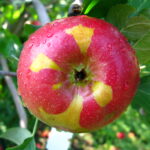Tank mixtures (or tank-mixing) describes the process where multiple crop protection chemicals are combined in a single tank for simultaneous application. Tank-mixing pesticides allows the grower to make a single application but manage multiple pests AND pesticide resistance issues. All specialty crops, especially fruit crops, have more pests and pathogens than field crops, along with higher insect and disease pressures by these pests. As a result, fruit crops require more a greater number of pesticides, with more frequent applications, over a longer period of time. One way to improve efficiencies with these applications is by tank-mixing.
Many new growers are unclear and/or uncertain about tank mixes. Obviously, tank mixes save both time (during application) and money (improved pest management) as the grower only sprays the field once to manage multiple pests, instead of spraying two to three times to manage different insects and diseases. However, there are additional savings in that there is less chance of soil compaction, rutting or damaging trees or vines.
Tank mixing also improves pesticide resistance management. By combining two products (e.g., Rally+mancozeb, to control scab, rust, powdery mildew, bitter rot) the applicator is also controlling resistant isolates of the pathogens that cause widespread fungicide failures. If Rally fails to control a pathogen, mancozeb can follow up. Growers may opt to add insect management as well and include a product like Actara for plum curculio control during first cover, for example. For all these pesticides, labels provide information and recommendations as to how to best do this (Fig. 1). Remember: The label isn’t just a legal document, but also a history lesson of everything that has gone wrong. It pays to review the label even though it is tedious.
So, what can go wrong? Not all pesticides can be tank mixed, and some chemical or biological incompatibilities exist. How chemicals interact can be positive (synergism) or negative (antagonism) in a tank mix. Synergy of pesticides can increase potency which can harm the plants, which is why labels say to never tank mix copper with Aliette or other phosphorous acid fungicides. We harness synergy by adding an acidifier to captan to maintain a neutral or acid pH, but too much can result in phytotoxicity. The captan label warns about this (Fig. 2).
Unfortunately, some tank mixes result in antagonism, where the chemicals cross react in a way that reduces their efficacy resulting in less control of the problem. This usually results usually from physical incompatibilities (e.g., tank sludge) that occur when liquid pesticides crash out of solution or dry products fail to dissolve in the tank. Both result in clogging of lines, screens and nozzles, prevent spraying, and result in a loss of time, instead of savings, which is why reading the label to avoid this occurrence is so important.
Avoiding sludge can be as simple as following the prescribed mixing order. Remember, we aren’t witches over a cauldron (although it may feel like that sometimes). Make sure the tank is ~ ½ full of water before adding the first product. Check the water to make sure pH is where you think it should be (usually around pH 7, but check the label), and make sure water quality is good (hardness, salts and salinity, bicarbonates, turbidity). Although we have good water in Indiana, it is fairly hard and alkaline. Most pesticides are formulated to address this issue, so water conditioners usually aren’t needed for insect and pathogen control.
Mixing order of pesticides matters. Use the W.A.L.E.S. acronym to order what you put in the tank.
- Wettable powders
- Agitate
- Liquid flowables
- Emulsifiable concentrates
- Surfactants
Compatibility agents and/or anti-foaming agents should go in the tank before the pesticides. If adding adjuvants, be sure to read the label to know when to add, recognizing that many pesticides are formulated with adjuvants and that additional adjuvants may not be necessary, and may actually cause additional phytotoxicity issues (Fig. 3). Finally, don’t rush your mixing, especially if water is extremely cold (spring in Indiana!) or using dry products.
Tank mixing is a great way to improve applications and save time, but they aren’t a silver bullet (which only work on werewolves, anyway). Keep in mind that there is too much of a good thing, and that the more products in the tank mix increases the chance for problems (antagonism, synergism, or just plain incompatibility). To prevent these problems, or end up having to clean a tank instead of spraying, plan ahead as to what you are managing and what you plan to apply. Check the label! Instead of pulling out the readers and searching through 6 point font, download the pdf version (google the name of the product. E.g., search for “Rally fungicide label” or “Actara insecticide label). Open up the pdf and search (Command+F on Macintosh or CTRL+F on a PC) for “mixing procedure”, “tank mix”, “mix”, or “compatibility”.
- Figure 1. The Actara label provides information for effective tank mixing.
- Figure 2. The captan label warns against specific pesticides and tank mixes.
- Figure 3. What happens when you ignore the warnings! Photo by Janna Beckerman.
For more information:
Avoiding Tank Mixing Errors – https://ppp.purdue.edu//wp-content/uploads/files/PPP-122.pdf
Tank Mix Compatibility – https://sprayers101.com/tankmix/


